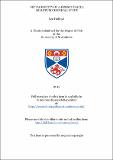Mutagenicity of 5-bromouracil : quantum chemical study
Abstract
This thesis describes a computational investigation of the mutagenicity of 5-bromouracil (BrU).
In Chapter 1, three models of spontaneous and BrU-induced base mispairing (rare tautomer, wobble pair, and ion) are reviewed.
Chapter 2 presents the computational techniques used: electronic structure methods (Hartree–Fock-based and density functional theory) and molecular dynamics.
Chapter 3 presents optimisations of the keto and enol tautomers of BrU and uracil (U) in water clusters. The enol tautomer of BrU is found to be more stable than that of U.
Chapter 4 is a molecular dynamics study of the keto-enol tautomerism of BrU and U in a periodic water box. The pKₐ of BrU at N3 is found to be lower than that of U.
Chapter 5 is a study of stacked base dimers containing BrU, U, or thymine (T) stacking with natural bases. Some structures were taken from the Protein Data Bank, while others were generated using an in-house methodology. BrU is found to stack more strongly than T in vacuo, but solvation and thermal effects nullify this difference.
Chapter 6 discusses the significance of the results in Chapters 3–5 in terms of BrU-induced mutagenesis.
Appendices A and B–D provide supplementary material to Chapters 2 and 5, respectively.
Appendix E is an investigation of the “base flipping” pathway of 2-aminopurine (2AP). Both 2AP/N and A/N dinucleosides (N = thymine or guanine) are found to adopt a wide range of energy-minimum conformations – not only stacked and “flipped”, but also intermediate – and the stacked are not the most favourable by free energy.
Appendix F is a list of publications and papers in preparation. One publication concerns BrU stacking. The other is a conformational study of the dipeptide tyrosine-glycine: the theoretical results are shown to be consistent with experiment (R2PI spectra) if thermal effects are taken into account.
Type
Thesis, PhD Doctor of Philosophy
Collections
Items in the St Andrews Research Repository are protected by copyright, with all rights reserved, unless otherwise indicated.

